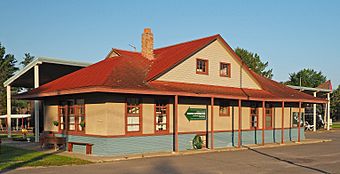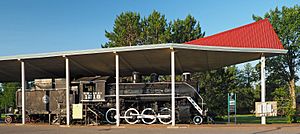Tower station (Minnesota) facts for kids
Quick facts for kids Tower station |
|
|---|---|
|
Duluth and Iron Range Railroad Company Passenger Station
|
|

The former station from the northeast
|
|
| Location | 404 Pine Street, Tower, Minnesota |
| Area | .75 acres (0.30 ha) |
| Built | 1916 |
| Built by | George Spurbeck |
| Architect | William H. Beyrer |
| NRHP reference No. | 13000380 |
| Added to NRHP | June 14, 2013 |
The Tower station, also known as the Tower Passenger Depot, is an old train station in Tower, Minnesota, United States. It's a special building because it's listed on the National Register of Historic Places, which means it's an important historical site.
This station was built in 1916 by the Duluth and Iron Range Railroad company. It served as a place where people could catch trains until 1951. Today, it's not a train station anymore. Instead, it's home to the Tower-Soudan Historical Society Center, a museum that teaches visitors about local history.
Contents
The Story of Tower Station
Early Railroad Days in Tower
The very first railroad track reached Tower in 1884. It was built by the Duluth and Iron Range Railroad (D&IR). This track was super important because it helped transport iron ore from the Soudan Mine, which had opened just a year before.
The first train station in Tower was built before 1886. Even though maps called it a passenger station, it was mostly used for moving goods and materials, not people.
Building a New Station for Travelers
Around 1908, the D&IR railroad company started encouraging people to visit the beautiful Lake Vermilion area. The old station wasn't great for tourists. It was designed for cargo and wasn't in a good spot for travelers.
So, in February 1916, the company announced plans for a brand new passenger station. Some people in Tower wanted it built in a more central spot, but their request was turned down.
The new station was designed by an architect named William H. Beyrer. A builder named George Spurbeck constructed it for $10,000. The building was finished later that year, and the first train arrived at the new station on November 25, 1916.
Trains Give Way to Cars
In the 1930s and 1940s, fewer people traveled by train. Cars became more popular, and roads got better. This meant people could drive to tourist spots all over the state, and Lake Vermilion wasn't as unique for train travelers anymore.
Because fewer people were riding trains, passenger service to the Tower station stopped in 1951. Freight service, which moved goods, also ended in 1962 when the Soudan Mine closed.
A Museum for History
In 1966, the D&IR railroad company gave the old station to the City of Tower. Later, it became the Tower-Soudan Historical Society Center. This museum now shares the history of the local area.
The station was recognized as an important historical site on June 14, 2013. It was added to the National Register of Historic Places because of its role in local tourism and transportation.
What the Station Looks Like
Building Design
The Tower station is a one-and-a-half story building made of wood. It's about 23.5 feet wide and 62.5 feet long. The outside walls are covered in clapboard (overlapping wooden boards) up to about 4 feet high. Above that, it's covered in stucco (a type of plaster).
The roof is shallow and has a complex hipped design, meaning all sides slope downwards to the walls. It also has a 5-foot overhang. Over time, the edges of the roof started to sag a bit. So, six strong wooden posts were added to help support it.
On the northwest side of the building, you can see a sign with the word "TOWER" in big block letters, right at the edge of the roof.
Outdoor Displays
Next to the station, along what used to be the loading platform, there's still a piece of railroad track. On this track, you'll find a cool display! It includes D&IR 218 (later called DM&IR 1218), which is a K class 2-8-0 steam locomotive. A locomotive is the engine part of a train. There's also its tender (which carries fuel and water), two train cars, and a caboose.
In 2008, a canopy was built to protect the locomotive and one of the passenger cars from the weather. In 2012, solar panels were added to this canopy. These panels now create electricity for the train cars and the station building!
West of the locomotive, there's a monument from 1901 dedicated to President William McKinley. It's made of sheet metal.
More to Explore




